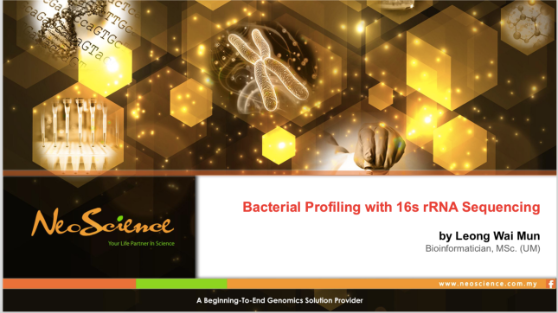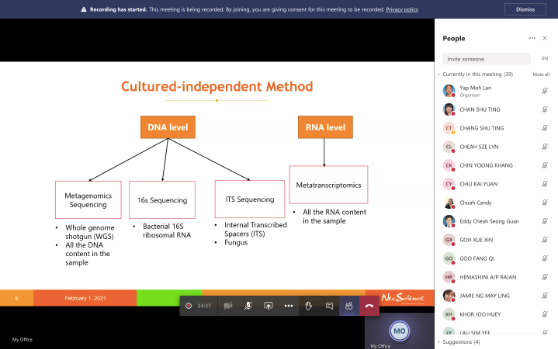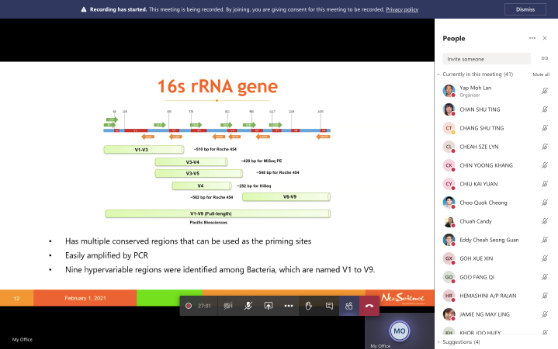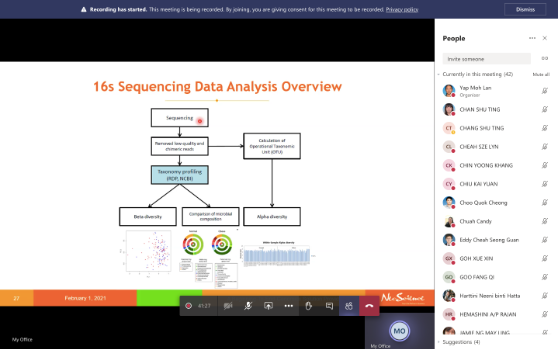A webinar on herbs that are beneficial for respiratory health
A webinar titled “Herbs Webinar 2021: Herbs for Respiratory Health” was jointly organised by Malaysia Holistic and Herbal Organisation (MHHO), UTAR Centre for Biomedical and Nutrition Research (CBNR) and UTAR Centre for Agriculture and Food Research (CAFR) on 20 December 2021 via Zoom and Facebook Live. Sponsored by Isolab Sdn Bhd, the event saw 140 participants in attendance.
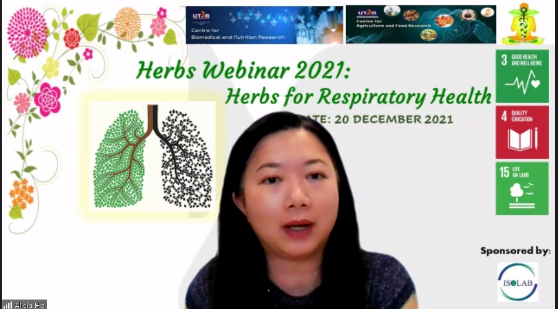
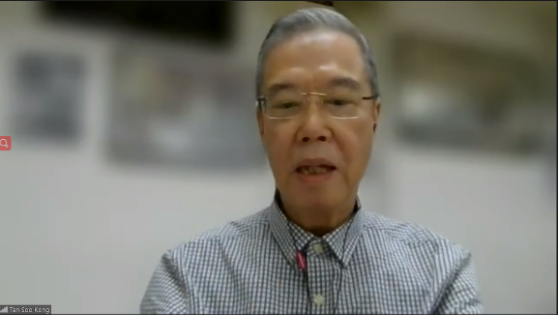
The webinar aimed to bring a group of imminent scientists and specialists together to share their knowledge on herbs that are beneficial for respiratory health to students, faculty staff, researchers, scientists, practitioners and the public.
Organising Chairperson-cum-FSc Department of Allied Health Sciences lecturer Dr Teh Lai Kuan expressed her gratitude to the organising committee, sponsor and participants during her welcome speech. She said, “This Herbs Webinar 2021 is our fifth event related to herbs. Since 2017, we have been organising the Local Herb’s Day Series. Last year, due to the pandemic, we held the first online Local Herb’s Day Series titled ‘Herbs Webinar 2020: Sustainable and Contemporary Practices’. Today’s event is our second online series that focuses on ‘Herbs for Respiratory Health’.”
Dr Teh welcoming the participants
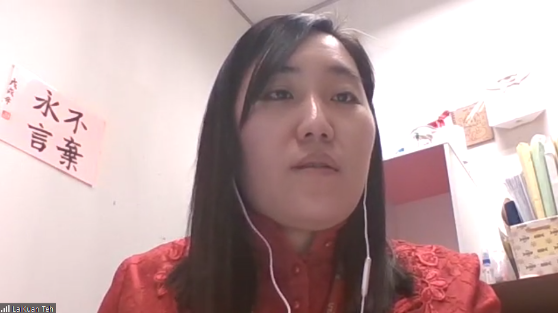
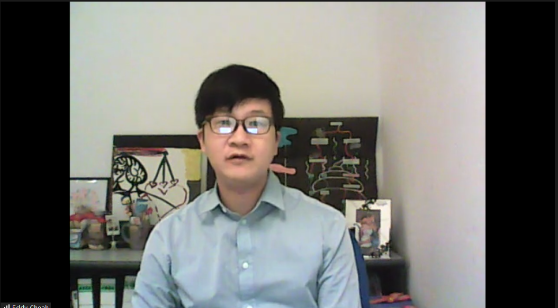
A video was played at the webinar to introduce the Local Herb’s Day Series. Following the video was welcome remarks by CBNR Chairperson-cum-FSc Department of Biological Science Dr Eddy Cheah Seong Guan.
“Alveoli are the functional unit of the lung where gas exchange takes place. If the alveoli are affected, the function of gas exchange will decrease. In any case of infection, the lungs would collapse and blood would fill into the lungs. Bacteria or virus usually enters the body through the airway. Once the infection gets into the respiratory system, the organism starts to multiply either in the upper or lower system. The symptoms will show up depending on the aggressiveness of the organism and your immune system. As time goes by, if the infection becomes severe, there will be inflammation in the air sacs, called alveoli, and the alveoli will be filled with fluid or pus. This will lead to symptoms like fever, breathing difficulties and cough (containing yellow or brown mucus). The patient will also feel more difficult to swallow when he or she breathes,” said Dr Inthirani.
She further explained, “If a person has a good immune system, the infection would not play out. Some may not show symptoms of infection if their immune system is strong. However, they will still carry the virus and the virus are highly infectious. These types of viruses are usually spread through droplets and air. The aim of our herbal treatment is to help patients preserve or improve their lung functions. Herbal treatment is found to act as anti-microbial, anti-viral, anti-inflammatory and immune stimulatory. Besides that, we need to have good food and good sleep to improve our immunity.”
Dr Lu spoke on the topic “The Comparison between Traditional Chinese Medicine and Western Medicine on Pulmonary Infection”. He said, “Traditional Chinese Medicine (TCM) and Western medicine have different understandings of aetiology, pathogenesis and pathology, as well as different diagnosis and treatment methods. In Western medicine, lung infections refer to pulmonary infections. It is treated as a common disease before the pathological diagnosis is confirmed. The diagnosis of the Covid-19 is confirmed after the nucleic acid test positive. According to the TCM theory,the lungs is connected to the large intestine; constipation occurs during pulmonary infection with internal heat syndrome. TCM uses the Four Methods Physical Examination (四诊) and Eight Principles Syndromes (八钢) to determine the nature of the pathological changes, based on the patient’s respiratory symptoms, thereby providing the basis for treatment with herbal medicine.”
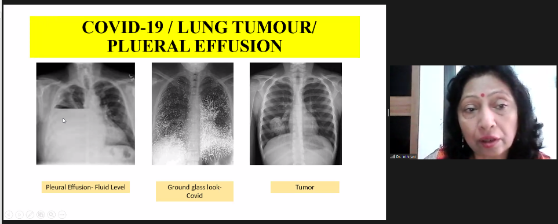 Dr Inthirani presenting the X-ray of lungs that are infected by virus
Dr Inthirani presenting the X-ray of lungs that are infected by virus
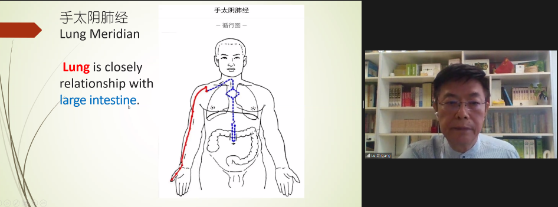 Dr Lu explaining the lung meridian in TCM
Dr Lu explaining the lung meridian in TCM
During his talk session titled “From A TCM Perspective: Harmony of the Lung System”, Dr Te spoke on the zang-fu (脏腑) organ’s concept, the five elements theory (五行), the understanding of lungs from the Chinese Medicine perspective, as well as the harmony of the lung system with Covid-19. He also presented the Chinese Medicine Practice Guidelines for the Covid-19 in Malaysia. According to Dr Te, TCM Malaysia is doing telemedicine to the public.
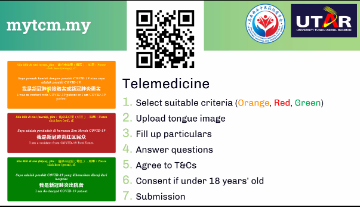
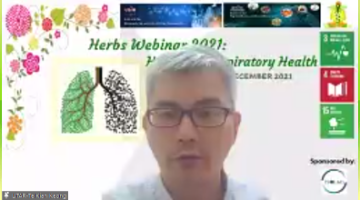 Dr Te during the webinar
Dr Te during the webinar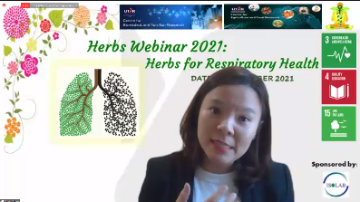 Chan sharing the importance of considering the quality and safety of herbs
Chan sharing the importance of considering the quality and safety of herbsShe added, “We must be very careful when we use Chinese herbs to treat patients. Some patients might be allergic to certain herbs and this could potentially cause death if it is not administered properly. There was an incident about a young patient who suffered from internal bleeding due to the misuse of herbs. After investigation, they found out that this young patient had consumed homemade kadha (an Ayurvedic remedy that helps in fighting seasonal infections) daily for the past five months. It was believed that toxins were excreted from the kadha.”
“Many TCM practitioners tend to look over the adverse effects of herbal medicine or dietary supplements in G6PD deficiency. So, I advise all TCM practitioners to be careful of the adverse effects. To provide better treatment to patients, we need to be aware of the safety of herbal medicines. We should have evidence-based and value-based medicines to improve the whole medical system for our nation,” said Chan.
FSc Dean Assoc Prof Dr Lim Tuck Meng said during the closing remarks, “It is very important that we have the accurate and correct information in this era before we make any good decision, especially in terms of receiving treatments. It is known that the Asian civilisation has a long history of fighting against pandemics, particularly in China, where most of these are probably recorded, and today we learn a lot from their experiences and techniques which could be modified to suit our modern life. It is interesting to see that the members of the faculty have this passion to continue these activities which started in 2017. I believe that you would agree with me that they have achieved the objective of this event when we saw many questions posted and interesting discussions held after the end of each talk. I hope that the effort will be continued in the future.”
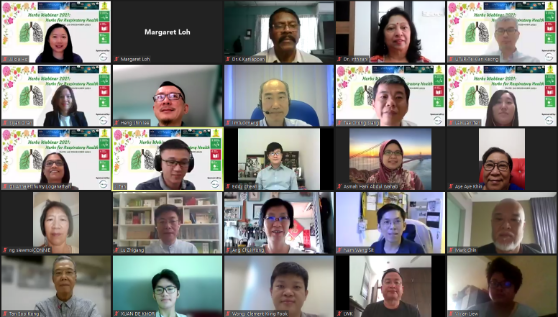
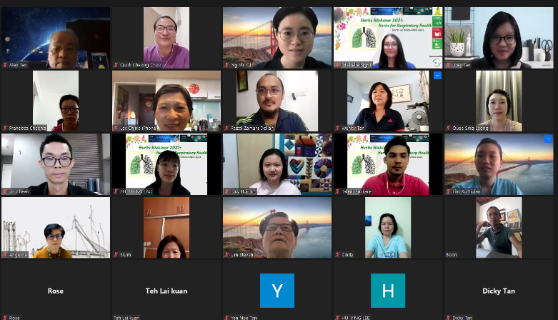
Webinar on Healthy Ageing -
How to reduce Risk of Falls and Maintain Good Health
The Department of Allied Health Sciences (DAHS), Faculty of Science, UTAR had organised the Webinar on Healthy Ageing - How to Reduce Risk of Falls and Maintain Good Health on 22nd October 2021 (Friday) from 10:00 am to 11:30 am. The objectives of this event were to enhance knowledge of fall risk and ways to prevent falls in the elderly, and promote healthy eating among elderly to reduce the risk of non-communicable diseases. This event was conducted online through ZOOM and Facebook live (Krt Panorama Lapangan Perdana - Giorgio). Two distinguished speakers, Dr. Annaletchumy Loganathan and Dr. Ben You Yee Xing, were invited to deliver talks on specific topics targeting the elderly population, healthcare professionals and the public. This webinar was supported by Centre for Biomedical and Nutrition Research, and co-organised by Rukun Tetangga Kawasan Panorama Lapangan Perdana Giorgio, Bandar Cyber Ipoh and the Malaysian Healthy Ageing Society. Through this webinar, participants learned that the risk of falls can be reduced with proper management, and healthy eating can be promoted to achieve better quality of life.
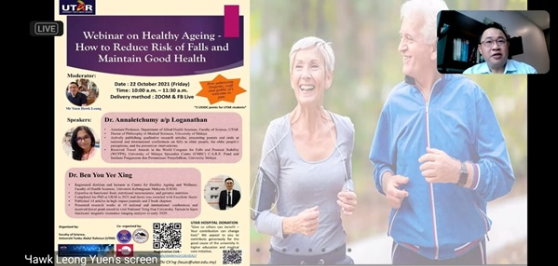 The moderator, Mr. Yuen Hawk Leong, welcomed the
speakers and participants and give an introduction about the webinar.
The moderator, Mr. Yuen Hawk Leong, welcomed the
speakers and participants and give an introduction about the webinar.
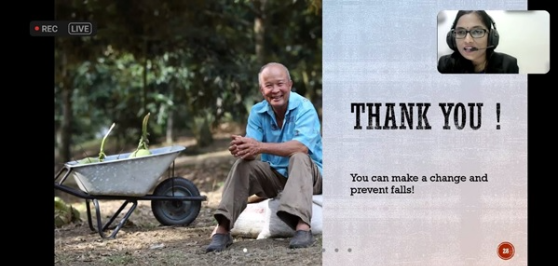 The first speaker, Dr. Annaletchumy Loganathan, shared
her knowledge on falls and how to reduce risk of falls among older adults.
The first speaker, Dr. Annaletchumy Loganathan, shared
her knowledge on falls and how to reduce risk of falls among older adults.
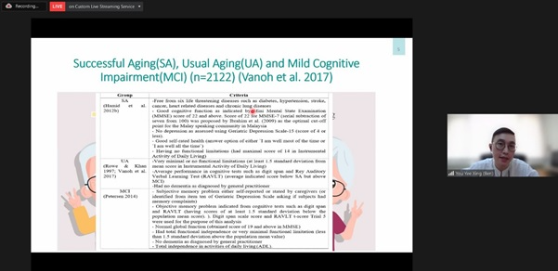 The second speaker, Dr. Ben You Yee Xing, shared some
common nutritional problems faced by the elderly and ways to ensure adequate
nutrient intake among the ageing population.
The second speaker, Dr. Ben You Yee Xing, shared some
common nutritional problems faced by the elderly and ways to ensure adequate
nutrient intake among the ageing population.
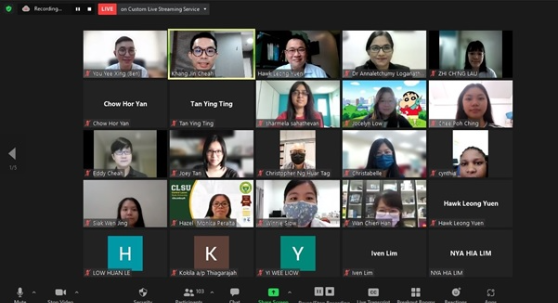 Participants took a group photo at the end of the webinar.
Participants took a group photo at the end of the webinar.
International Webinar on Advanced Scanning & Transmission Electron Microscopy 2021
(i-WASTEM 2021)
The webinar, which was hosted on Zoom, was officiated by Assoc, Prof. Dr. Lim Tuck Meng, Dean, Faculty of Science, UTAR. It featured talks by five eminent speakers from Malaysia, India and Brazil who are experts in scanning and transmission electron microscopy. A total of 483 participants attended this webinar and they were from Malaysia, India, Sri Lanka, Saudi Arabia and Japan.
The i-WASTEM 2021 aimed to enable the participants to learn the working principles of SEM & TEM, their operating and optimizing procedures and other necessary skills to acquire high-quality images, their use as qualitative and quantitative analytical tools and the latest developments of their applications in bioscience research..
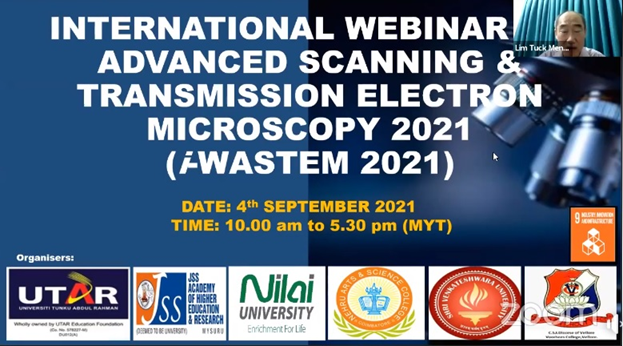
Opening address by Assoc. Prof. Dr. Lim Tuck Meng, Dean, Faculty of Science, UTAR
Processes (LPQ), Brazilian Agricultural Research Corporation, Brazil
Talk title: Cellulose nanofiber sample preparation, and imaging of thick samples using EFTEM

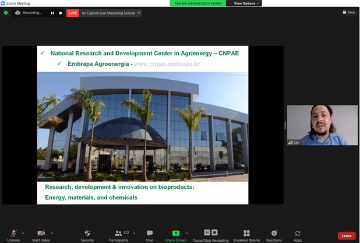 Invited talk by Dr. Leonardo Fonseca Valadares
Invited talk by Dr. Leonardo Fonseca Valadares
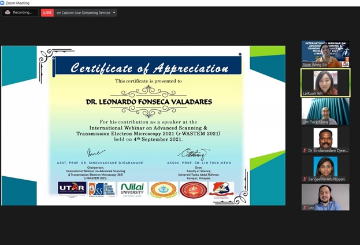 Certificate
of appreciation presented to Dr. Leonardo Fonseca Valadares by Dr. Lim Tuck
Meng
Certificate
of appreciation presented to Dr. Leonardo Fonseca Valadares by Dr. Lim Tuck
Meng
Invited talk by Prof. Dr. P. Lalitha, Professor of Chemistry & Coordinator for Bharat Ratna Prof. CNR Rao Research Centre, Avinashilingam Institute for Home Science & Higher Education for Women (Deemed University), India
Talk title: Basics of FESEM and its applications
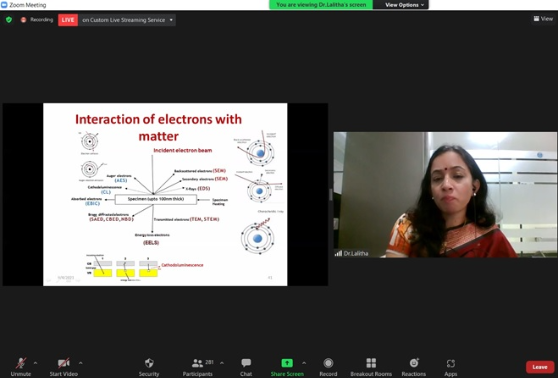 Invited talk by Prof. Dr. P. Lalitha
Invited talk by Prof. Dr. P. Lalitha
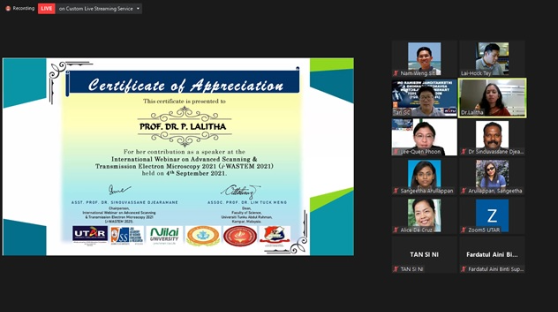 Certificate
of appreciation presented to Prof. Dr. P. Lalitha by Dr. Phoon Lee Quen
Certificate
of appreciation presented to Prof. Dr. P. Lalitha by Dr. Phoon Lee Quen
Talk title: Physics of images formation in electron microscopes and their applications
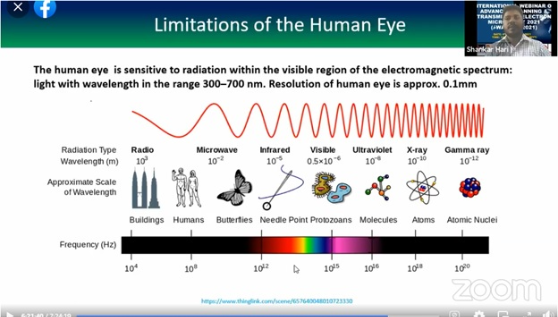 Invited talk by Dr. Shankar Hari
Invited talk by Dr. Shankar Hari
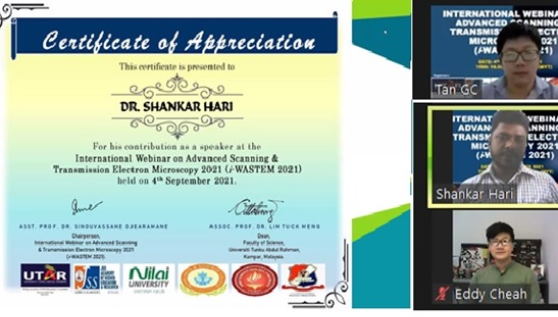 Certificate
of appreciation presented to Dr. Shankar Hari by Dr. Eddy Cheah Seong Guan
Certificate
of appreciation presented to Dr. Shankar Hari by Dr. Eddy Cheah Seong Guan
Invited talk by Mr. Patchamuthu Ramasamy, Senior Application Specialist, Hi-Tech Instruments Sdn. Bhd., Penang Branch, Malaysia
Talk title: Basic sample preparation techniques for TEM
 Invited talk by Mr. Patchamuthu Ramasamy
Invited talk by Mr. Patchamuthu Ramasamy
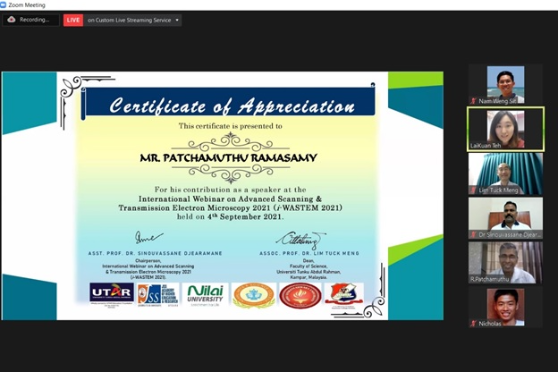 Certificate
of appreciation presented to Mr. Patchamuthu Ramasamy by Dr. Lim Tuck Meng
Certificate
of appreciation presented to Mr. Patchamuthu Ramasamy by Dr. Lim Tuck Meng
Invited talk by Mr. Ooh Keng Fei (Nicholas), Laboratory Manager, Department of Laboratory Management and Safety Administration, Faculty of Science, UTAR, Malaysia
Talk title: Video demonstration on operation and sample preparation for SEM
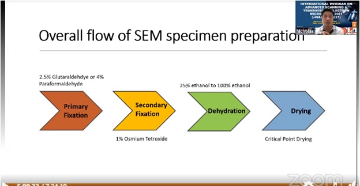 Invited talk by Mr. Ooh Keng Fei (Nicholas)
Invited talk by Mr. Ooh Keng Fei (Nicholas)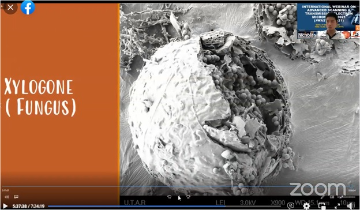
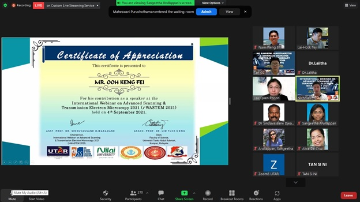 Certificate
of appreciation presented to Mr. Ooh Keng Fei by Dr. Phoon Lee Quen
Certificate
of appreciation presented to Mr. Ooh Keng Fei by Dr. Phoon Lee QuenClosing Remark by Dr. Sinouvassane Djearamane, the Chairperson of i-WASTEM 2021
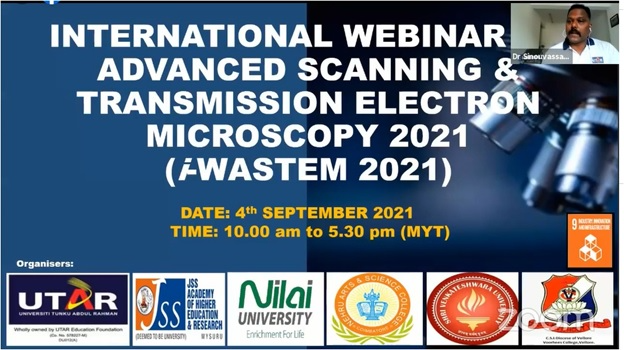

Photo of organising committee
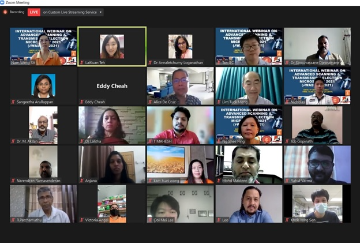
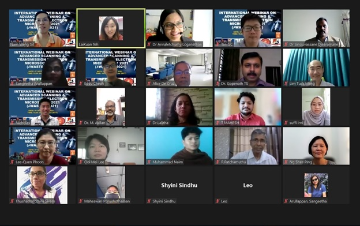
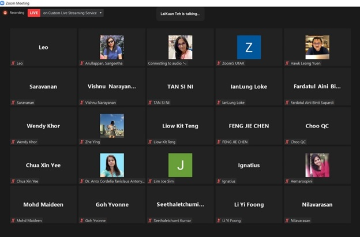
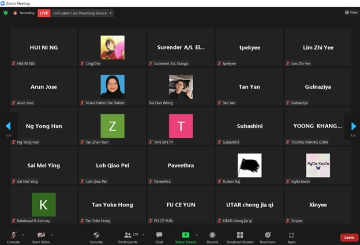
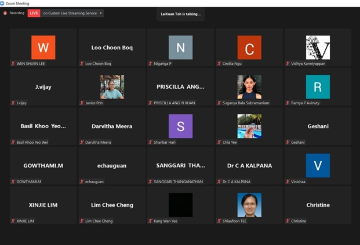
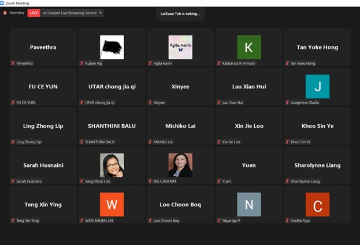
Producing blood from stem cell for blood transfusion
UTAR Centre for Biomedical and Nutrition Research (CBNR) parked under Faculty of Science (FSc) organised a webinar titled "Blood Production from Stem Cell for Tomorrow's Blood Transfusion: From Hype to Hope" on 5 April 2021 via Zoom.
Moderated by FSc Deputy Dean for Academic Development and Undergraduate Programmes Assoc Prof Dr Gideon Khoo, the event aimed to highlight the severity of thrombocytopenia, which is a condition characterised by abnormally low levels of platelets. The organiser also hoped to educate students and the public with knowledge on how hematopoietic stem cells in platelet production could be used as an alternative intervention towards sustaining human health and well-being.
Invited to deliver the talk was Mahidol University (Bangkok, Thailand) Faculty of Medicine Siriraj Hospital Siriraj Center of Excellence for Stem Cells Research (SiSCR) Senior Researcher Dr Chanchao Lorthongpanich. Dr Chanchao and her research team have developed an in vitro production system which is designed to increase the yield of red blood cells (RBC) and platelets from iPSCs – derived Hematopoietic stem cells (HSCs). The webinar, therefore, aimed to enlighten the participants on the value of using Hematopoietic stem cells in platelet production for thrombocytopenia treatment.
Also present at the webinar were CBNR Chairperson Dr Eddy Cheah Seong Guan, FSc Department of Biological Science Head Dr Nor Ismaliza binti Mohd Ismail, FSc Department of Agricultural and Food Science lecturer Dr Kwong Phek Jin and FSc Department of Allied Health Sciences lecturer Dr Michelle Ng Yeen Tan. The webinar saw 137 participants from UTAR, Universiti Putra Malaysia (UPM), Universiti Kebangsaan Malaysia (UKM), International Islamic University Malaysia (IIUM), Sunway University (Malaysia), Newcastle University (United Kingdom), University of Nottingham (United Kingdom), Mahidol University (Thailand), Chulalongkorn University (Thailand) and Prince of Songkla University (Thailand).
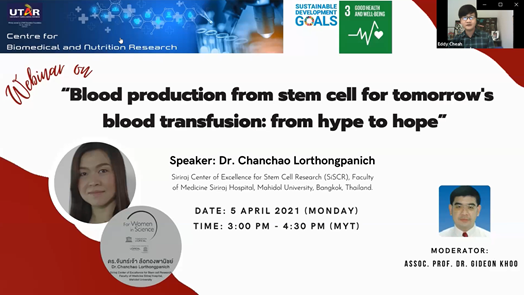
Dr. Cheah giving his opening speech
In his welcome speech, Dr Cheah said, “In recent years, stem cell therapy has become a very promising research topic and the current market for stem cell therapy has also expanded significantly. Besides that, the wide variety of possibilities made stem cell therapy a turning point in modern medicine. It is providing hope for some of the world’s most challenging diseases. In order to provide a platform for research collaboration opportunities with Malaysian research institutions in this stem cell research area, CBNR invited Dr Chanchao who is an expert in stem cell and blood production to share her research study at this webinar.”
The opening speech was followed by Dr Chanchao’s sharing on her research. She kick-started her talk by introducing her research team member from SiSCR. Throughout the talk, she discussed the role of Hippo in signalling pathway on pluripotency and the differentiation in the capacity of iPSC and HSCs when the expression of some Hippo signalling component genes is altered. She also discussed the potential use of an FDA (approved drug) in the generation of blood cells.
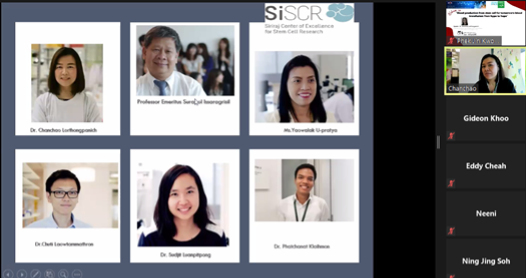
Dr. Chanchao introducing her research team members from SiSCR
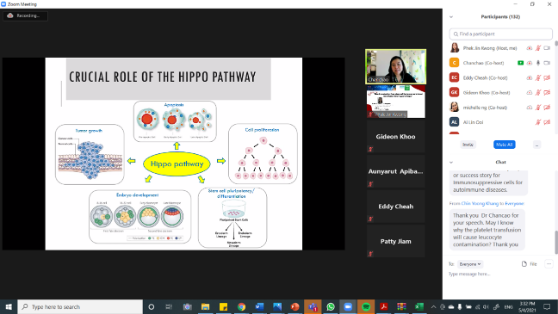
Dr. Chanchao explaining the crucial role of the Hippo pathway
While explaining about blood transfusion, Dr Chanchao said, “Blood transfusion is potentially a life-saving procedure that can help replace blood lost due to surgery or injury. In addition, a blood transfusion also helps when an illness prevents your body from making blood. If your body is missing one or more of the components that make up healthy blood, a transfusion can help replace what your body is missing.”
She added, “Many hospitals are facing blood supply shortage. In order to solve the problem, we developed an in vitro production system as an alternative for someone who needs blood supply. This is because an inadequate blood supply may pose danger to patients if the proper amount and type of blood is not made available when needed.”
Dr Chanchao also talked about the reliability of stem cell-derived blood product as well as the crucial role of Hippo pathway. She mentioned two strong points that sustained the stem cell-derived blood product. “Firstly, the bone marrow transplantation procedure is already well established. Secondly, blood cell can be sorted into pure population before transplantation or transfusion,” said Dr Chanchao.
The talk then ended with a Q&A session and a group photography session.
To view the full video, click
https://drive.google.com/file/d/1BJ7Qs6DTGplNsP0XZkjgOEOub9ZQpTU3/view
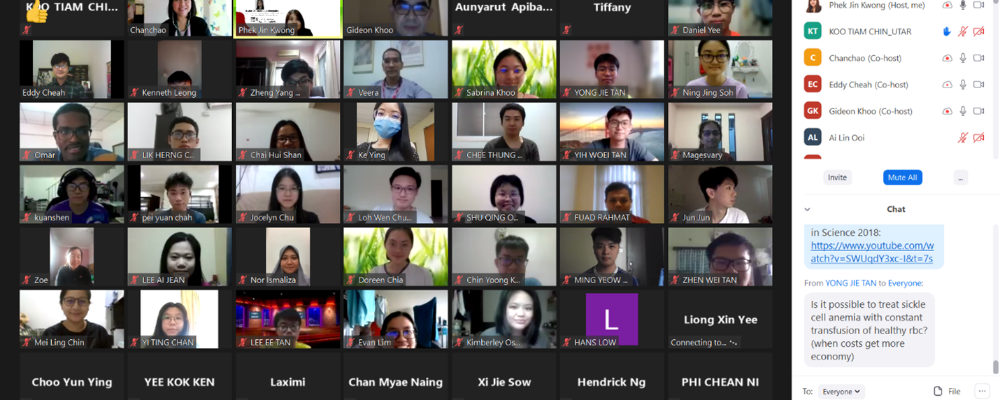
Dr. Chanchao (top row, second from left) taking group photos with participants
Webinar: Sequencing-based genomics surveillance helps to fight the pandemic
23 March 2021, 3:00 pm - 4:00 pm (Google meet)
Three speakers, Mr. Khairul Luqman, Dr. Eric Yang Shun Kai and Ms. Lye Siew Fen, were presented on this webinar. They were presenting about:

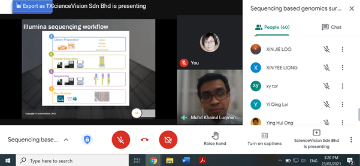

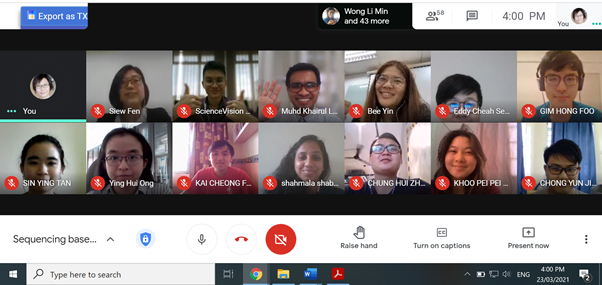
Webinar: Bacteria Profiling with Whole-Metagenome Sequencing and 16S rRNA Gene Sequencing
1 February 2021, 2:00 pm - 3:30 pm (MS Teams)
Speaker shared her knowledge and experience on:
- Whole-metagenome sequencing and 16S rRNA gene sequencing technology
- The basic principles, workflow and applications of NGS
- NGS data processing and analysis
- NGS service and products available on the market
